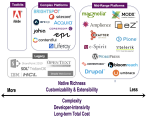Which Do You Select First - Vendor or Integrator?
We get this question a lot. As MarTech stacks get more complex and integration-centric, they require more expertise to implement — expertise typically found by investing in outside services from consultancies, integrators, and vendor "channel partners."
We see many web content and experience management (WCM) or customer data platform (CDP) projects, for example, requiring the same coefficients for consulting costs as any other big enterprise project. That is: customers are spending 2-6x more on initial implementation services than they do on licensing costs. Same for outbound marketing and ecommerce projects. SaaS vendors with more productized, multi-tenant solutions talk about "quick start" projects with light professional services fees, but the "MVPs" that results tend to long on the M and light on the V.
Consequently, many MarTech implementations never really end. Just as vendors now charge annual subscription fees, the ongoing nature of most MarTech and CX programs means that most enterprises are regularly engaging services firms throughout the lifespan of a platform.
Given that ratio or spend, does it make sense to focus more on the implementation partner than the technology vendor?
Actually, no. Partners come and go, but your choice of software will stick with you for a long, long time. Put another way: there's sixty ways to leave your integrator, but only one very unpleasant way to leave your vendor.
What are you asking of your consultants?
Whenever you start a technology project, get clear about what you need from any outside consultants. There's a good chance you may need various "soft skills" such as information and process analysis, user experience, and change management, along with migration support. Your software vendor's own professional services arm — which focuses more narrowly on getting their technology implemented — likely won't prove very strong here.
Other times, though, you may only need specialized system implementation support and training based on a clear specifications you've already developed, in which case a broad-scale consulting firm would present a poor fit.
The larger point here is that you need to recognize the strengths and weaknesses of agencies versus systems integrators versus vendor services arms. Don't trust that one will do the other's job as well as you need.
In fact, within larger MarTech projects, we often see the customer supported by a combination of a design agency, integrator, and vendor professional services arm. Managing this troika is never a walk in the park. But organizations with strong management and a solid strategic vision can exploit specialized external talent for substantial competitive benefit. It still begs the question, though, of which to pick first.
Pick a services partner first?
You could pick the services partner first, and let them bring in the tool they think is best. We tend to recommend this only if you are looking to implement several major packaged solutions simultaneously, and need a general contractor to prove how they can piece together the all the right parts. For most customers seeking a single type of technology, though, this represents a high-risk approach for all but the smallest projects. Integrators will naturally tend to steer you towards the limited set of tools they know (or have a vested interest in), and away from the kind of composable stack that serves your best long-term interests.
A primer on switching costs
Any assessment of long-term risks and rewards has to look at switching costs. Replacing a consultant or integrator is certainly painful. They know you, they know the code they wrote, and ideally you've both invested in a close relationship.
But at the end of the day, it's tougher to leave your platform vendor. Your content and data are structured for their repository. Your templates, data models, workflows, and other customizations are tied to their system. Your ability to customize and extend the platform is tied to their API.
If changing integrators is like switching plumbers, then changing vendors is like remodeling your bathroom completely. Get a blueprint, select the fixtures, then find the plumber.

Buy the sink first, then get the plumber to install it.
A combined approach
So in an ideal world, you would pick the software vendor first, then have a second round of competition for a services partner or two. We have mentored and counseled many enterprises in this approach, and it works well. The downside is that it takes more time and effort up front, even if it pays off in the long run.
For those on a faster track, we sometimes recommend a "combination" RFP. In this approach, you ask the technology vendor and services partner to bid together, and you evaluate them together. You do face some complications with this approach, most notably that supplier selection becomes a more multivariant problem.
But in our experience it can work pretty well. You may find multiple tools that present a good fit, in which case the partner fit may prove decisive. You may discover that you like the technology, but not the partner, and therefore get a jump-start on the second phase of your selection. We've participated in one selection processes where multiple partners brought the same software vendor to the dance, which proved very educational for the customer.
We've also witnessed cases where the customer ended up choosing Vendor A's technology but Vendor B's integrator. If that sounds like a kind of swingers party, well, all I can say is you should exercise all the relevant precautions here. If Integrator B doesn't know Vendor A's platform very well, you have some serious risks to mitigate. But it can work, especially if you've followed the advice above and gotten very clear about what skills you're looking for in a partner.
Some other benefits
A "combination" selection approach can also yield other benefits. First, this approach more amenable to SaaS-based providers, who typically promote an integrated technology+services model that might not fit neatly into solicitations targeting just technology or only services.
It also provides more opportunities to clearly evaluate open source platforms, where you often need to engage a 3rd-party integrator to fully understand the platform. By inviting services firms, you give open source (especially community-based open source platforms) a better shot.
If you're looking to select technology and want to learn real story about different marketplaces, contact us to see how we can help.








